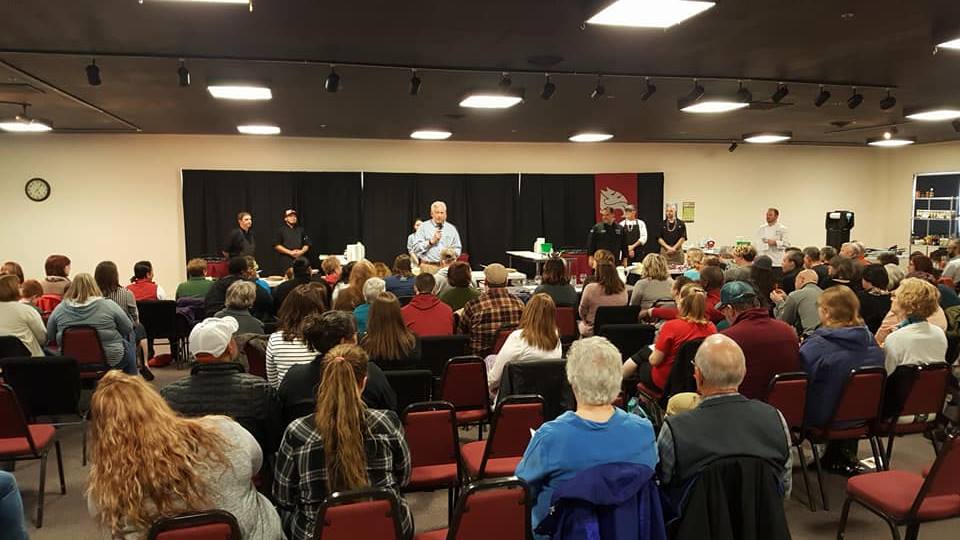How Can We Help?

Facilitating Community Engagements
Facilitating Community Engagements is all about starting a dialogue with potential key community stakeholders and members, maintaining and engaging those relationships, and working together where needed.
Community engagement was a huge part of the Palouse Tables Project. Community engagement took the form of tabling, community meetings, focus groups, interviews, surveys, and maintaining a presence online through Facebook and an e-newsletter. This was crucial because it accomplished two main goals including collecting information from the community as well as keeping them informed and involved throughout the course of the project.
In the beginning stages of the Palouse Tables Project, collecting information was a priority. To conduct a community meeting, for example, phone calls, presentations, emails, press releases, hanging posters, handing out flyers in water bills, meeting stakeholders was an initial step to start building a relationship. Invitations were extended to community members by these means to attend a community meeting. Collaborating with churches and food pantry managers often resulted in high attendance, which for this project, was roughly 20-25 people. Everyone was invited; aside from churches and food bank managers, school faculty and staff, government officials, garden clubs, the libraries, the press, anyone and everyone was invited. Community meetings, focus groups, and anything that required a large number of community members involved advertising anywhere from a week to a month in advance depending on the size of the community.
Once community meetings were scheduled, every meeting was conducted the same in each community. This included providing having a sign in sheet to record people’s information, other available resources for food security, food since it was set around dinner time, opening up the discussion with what works well in the community (discover), imagining a future of food and food security (dream), and putting everything together (design). The concept of Appreciative Inquiry was used to collect information from community members. The comments community members had were recorded in sticky notes that were coded by color to Needs, Assets, and Partnerships. Meanwhile, the VISTA would usually take more detailed notes on the conversation to provide context for the notes and any background information necessary. To remain engaged after the community meeting, attendees were invited to sign up for the e-newsletter or to stay connected in other ways like subscribing to the Whitman County Food Coalition or the Palouse- Clearwater Food Coalition. Facebook posts and e-newsletters often shared the highlights of each community meeting and the ideas shared so that the wider community remained updated.
Focus group engagement was conducted a little differently. These were to hone in on clients that use any type of food assistance whether that is the food bank, Basic Food, meal sites, or any other means of getting food. Handouts were distributed at the several food pantries in person. An incentive of a $10 gift card was included for their participation. Once the meeting took place, people were asked to sign in and if they wanted to stay connected and updated about the project. Questions were asked and recorded via an electronic recorder. Participants were asked to sign a waiver where they understood their privacy would remain confidential and that recordings were only used for the purposes of this project and deleted once it fulfilled its purposes.
Interviews among key stakeholders was another way to reach out for data and to engage with the public. Interviews took place with government officials, farmers, food retail owners, food bank managers, composters, just to name a few. Interviews ranged from formal to informal and took place at times convenient for the interviewee in methods they felt comfortable with whether it was an interview that took place in person, by phone, or by email. They were also asked if they wanted to be updated and receive e-newsletter subscriptions or to keep updated through Facebook.
Aside from collecting information, community engagement was also included in the phase of Confirming the Results. This included creating an interactive, simple, diagram for a dot survey that was coded and themed according to the results of the community meetings. Community members were asked which aspect of the community food system needed the most Regenerating. Regeneration was a concept created after looking through all the data collected and trying to find one major theme for them all. An online survey was also created where people could also take the survey if they could not take it in person. The survey also allowed for comments on the concept of Regeneration and anything else people would like to share. The in-person dot surveys were done at several locations including the Latah County Fair, the Palouse Empire Fair, the Lentil Festival, distribution sites for the food pantry, and at meetings of the Whitman County Food Coalition, steering committees of the Pullman 2040 group, and the steering committee for food security of the Community Action Center.
Future engagement includes working on the vision created by all these communities at the 2019 Food Summit and further collaboration with invested community members throughout the Palouse.


